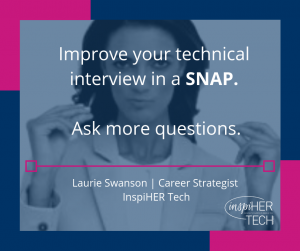| I recently watched a Lisa Nichols YouTube video. She was talking about something she learned as a young coach on how to create a powerful elevator pitch, something she called the S.N.A.A.P. As I listened to her, I realized that with just a small amount of modification this could be a powerful way to answer the question you can pretty much predict with 100% assurance you will have to answer on an interview: Tell me about yourself?When I coach job seekers, we talk about the fact that this question may seem straight forward but in fact can be very tricky. Sometimes it is just the easiest of icebreakers for any interview and other interviewers may use this question to evaluate your response as part of how they separate the people they will move forward to those who receive the thanks but no thanks email. You may ask yourself: - Is the interviewer wanting to know just about my career history?
- Does the interviewer want me to tell them about something personal as well?
- How do I know what is too little and what is too much of a response?
See what I mean by tricky? Your stress levels are probably already on the rise and it is just the first question! Relax, I got you. I have devised a simple process that will respond to all of these eventualities with just a little bit of upfront work on your end. My version of S.N.A.A.P. is called…wait for it…SNAP. It is not an acronym but just a reminder that when you are asked this question you will have a complete response in a SNAP. The SNAP MethodStep One: Answer a question with a question Whenever you are not sure of the intent of a question ask for clarification. Interviewer: Tell me about yourself You: Happy to! Would you like me to stay focused on my career? You have now thrown the ball back to the interviewer asking them to direct you further. This way you can respond directly to what is important to them. Step Two: Using the SNAP method in response to the question “Can you please tell me about yourself?” First, give a quick overview of who you are: I am a certified project manager with over 10 years working in both the insurance and supply chain industries using Waterfall and Agile approaches to manage teams up to 20 and budgets up to $5 Million. Second: Give 1 or 2 examples of results you have achieved: Through my work I am viewed as a strategic partner to the business. One cool project I worked on was an acquisition which resulted in significant technology overlap. We thought it would take years to untangle. Through the use of the right PM tools and my previous experience in mergers and acquisitions I built a team and we were able to decommission several systems, get rid of 100’s of spreadsheets and narrow down the number of end user tools to a small set of products that gave us a clear and accurate vision of our data thereby achieving ROI within 12 months. Third: Add some benefits: What sets me apart from other PM’s is that I have strong business acumen that results in powerful business intelligence reporting for the stakeholders. I am a transparent communicator that not only seeks to deliver projects on time and on budget but projects that create value for my company and our customers. Step Three: End with a question: Once you have followed the SNAP method you will once again throw the ball back to the interviewer with a question of your own. Example: Did that answer your question? OR I can go into more detail if you would like? This way the interviewer has an easy opening to gather more info or redirect you if things have strayed a bit. No harm done. P.S. I timed this and even with a slow, calm response I said all of this in under ONE MINUTE. ADDED BONUS: You can easily modify the SNAP method to use in your networking efforts. You would just ask a slightly different question at the end as more of a call to action. For example-would you know of anyone who might be looking for someone with my background and experience? Let me know in our Facebook group once you have tried out your SNAP on an interview or at your next networking event. In fact, if you can, come to our Women in IT Meetup on February 19th where we will be practicing the SNAP method and talking about networking and building community. | 
